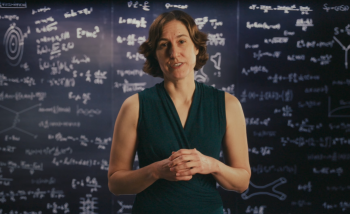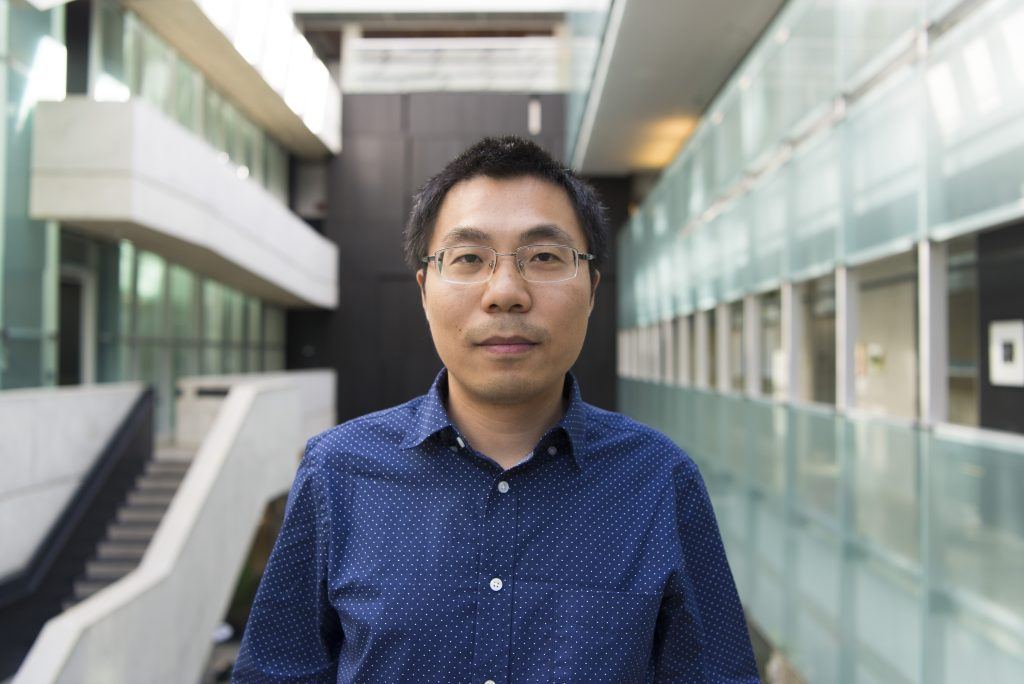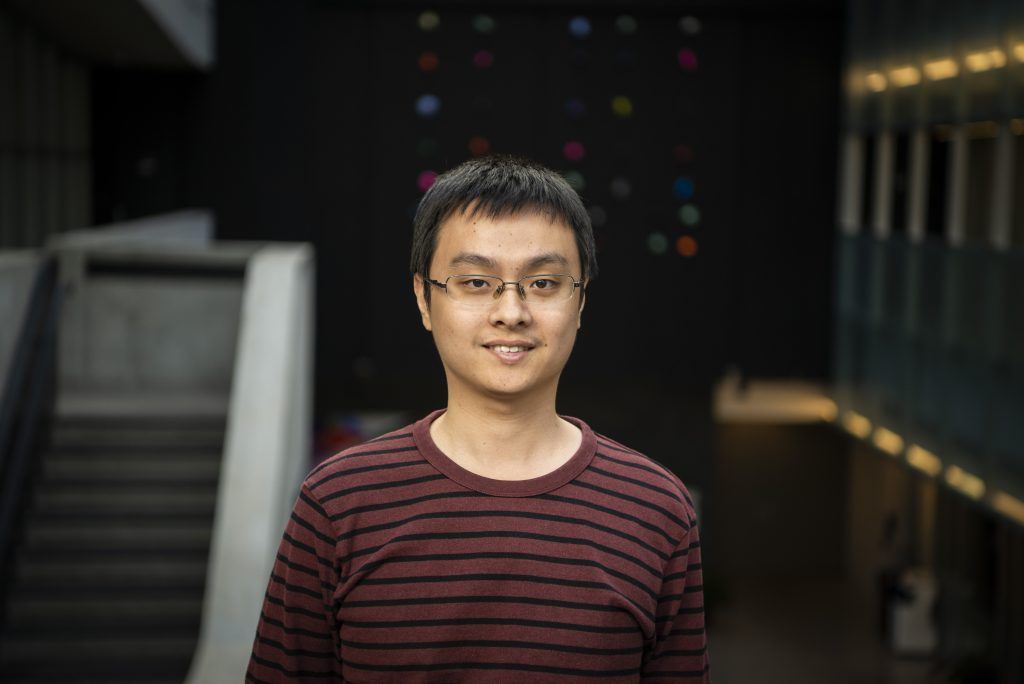For Chong Wang and his Perimeter colleagues Yin-Chen He and Liujun Zou, exploring quantum spin liquids is like deep diving into unexplored oceanic environments.
Just like the dazzling array of shapes, colours, and creatures in the oceans — such as sea whips that branch out of the surfaces of coral reefs— quantum spin liquids are exotic environments. In them, particles are swimming, shimmering, and interacting with each other in complex, highly entangled ways on crystal lattices such as triangular, kagome, and honeycomb structures.
The theoretical physicists who study these environments often say that it is like exploring a different universe, except instead of using a submersible or a spacecraft, their vehicle is mathematics.
“When we say that we explore them in a different universe, what we are saying is that for each material, there is some complicated mathematical description, but we can make it much simpler,” Wang explains.
“We theoretically picture the forms in another universe,” adds Zou. “Even if there is no pre-existing quantum material that is known to exhibit a phenomenon, we can point out that this phenomenon is theoretically possible.”
Faculty members Wang and He and postdoctoral researcher Zou are among the theoretical physicists connected to the Clay Riddell Centre for Quantum Matter at Perimeter, a research hub where scientists seek to harness the intrinsic properties of quantum mechanics to understand and uncover new states of matter.
They use mathematics to predict the possible configurations and movements of electrons in these geometric structures. And they study what happens on these lattices in different dimensions, such as one spatial dimension or two spatial dimensions instead of the three that we are used to. “Each dimension is a different challenge and has its own rich stories,” Wang says.
And just as in oceanic environments, fantastic new discoveries lie in wait in these theoretical other worlds.
One such recent deep theoretical dive by Wang, Zou, and He revealed a possible new class of quantum spin liquids they are calling Stiefel liquids, named after Swiss mathematician Eduard Stiefel (1909-1978).
Stiefel made important contributions to the field of topology or “rubber sheet geometry,” something that is also useful to the Perimeter scientists in their study of topological phases of matter, an area of physics that won the Nobel Prize in 2016. One of their papers, "Stiefel Liquids: Possible Non-Lagrangian Quantum Criticality from Intertwined Orders," was recently published in Physical Review X.
Quantum spin liquids and the Stiefel liquids subclass are not liquids in the conventional sense, but they are liquid-like states of matter.
In grade school, most people learn about the everyday states of matter – liquid, gas, or solid -- that can transition from one to the other depending on pressure or temperature. The most common is liquid water transitioning into ice or steam at different temperatures.
But there are many other states than those conventional ones. At extreme temperatures, near absolute zero for example, matter can also transition into Bose-Einstein condensates, a state where all the particles will bizarrely march in unison, as if they were one particle.
Quantum spin liquids as “frustrated magnets”
Quantum spin liquids are a state of matter akin to anti-magnets.
In magnets, electrons will line up their “spin,” or orient themselves in an orderly way, with their north poles pointing in the same direction. That is what gives the material its magnetic properties. At ultra-cold temperatures, many materials become magnetic.
But in quantum spin liquids, the configuration of the electrons on the lattices makes it difficult for the electrons to line up in an orderly way. If the electrons are interacting on a lattice with adjoining triangular patterns, a tug-of-war can ensue between the neighbouring electrons, and they will not know what to do. The material becomes a “frustrated magnet,” with electrons in a constantly fluctuating, liquid-like state, even at the lowest temperatures. Hence the name quantum spin liquid.
Quantum spin liquids were first proposed in 1973 by Nobel laureate Phil Anderson (1923-2020). Although purely theoretical at first, over the past decade experimentalists have documented materials that display quantum spin liquid properties.
The unique properties of quantum spin liquids might make them enormously useful in applications such as quantum computing or in achieving higher-temperature superconductivity where materials can transmit electricity with zero resistance even at room temperatures. “The original motivation for studying quantum spin liquids was to try to understand higher-temperature superconductors,” says He.
That is why quantum matter researchers all over the world, including the theoretical physicists at Perimeter, are on a quest to understand quantum spin liquids and discover new classes with different configurations and properties.
Stiefel liquids: A new class of quantum spin liquids
In their recent work, Wang, Zou, and He described how, at least in theory, the new class of quantum spin liquids they are calling Stiefel liquids could emerge.
A Stiefel liquid could be an example of a stable, strongly interacting system with long-range quantum electron entanglement, meaning that although the electrons are constantly fluctuating, they are tied together in their complicated dance across the material.
The strongly interacting fluctuating particles would constantly be exhibiting what is known as quantum criticality, that in-between stage where matter is transitioning from one phase to another. That makes quantum spin liquids ideal for understanding the emergence of collective behaviour, which is key to building new kinds of quantum materials with exotic properties.
Expanding the theoretical toolbox
But beyond this interesting quantum criticality, Zou adds that Stiefel liquids could force an expansion of the “theoretical toolbox” for understanding quantum matter in general.
The task of understanding quantum matter is what is known in physics as a “quantum many-body problem.” This refers to the fact that the complexity grows exponentially with the number of particles that are dancing together. It becomes hard — sometimes impossible, even using powerful modern computers — to describe them using the Schrödinger wave equations of quantum mechanics.
To simplify the task, theoretical physicists will typically utilize mathematical tools such as gauge theory to generate simpler approximations that help them build a picture of how quantum matter behaves. A common method is to use what are known as mean-field equations as an approximation technique to understand the more complicated, strongly interacting systems.
That approach, it turns out, does not apply to Stiefel liquids. “What we found is that Stiefel liquids seem to be beyond this paradigm, so this will require a new theoretical framework to describe,” Zou says.
“The Stiefel liquids in our proposal do not admit any mean-field descriptions, which means that we will need to have new theoretical tools to even study these intrinsically, strongly interacting systems properly,” Wang adds.
These new theoretical tools have yet to be fully developed, but the Stiefel liquids proposal opens that investigation. The hope is that experimentalists will one day find the properties of Stiefel liquids in a crystalline material, or by tweaking such a material in a lab.
“The optimistic hope is that some experimentalist may stumble upon its signatures,” Wang says.
But even if Stiefel liquids are not found, there is a broader importance to the work.
“It forces us to expand the horizons of our understanding," Zou adds. "It forces us to develop new tools, which can then be applied to other problems, and that may lead to a technological application.”
About PI
Perimeter Institute is the world’s largest research hub devoted to theoretical physics. The independent Institute was founded in 1999 to foster breakthroughs in the fundamental understanding of our universe, from the smallest particles to the entire cosmos. Research at Perimeter is motivated by the understanding that fundamental science advances human knowledge and catalyzes innovation, and that today’s theoretical physics is tomorrow’s technology. Located in the Region of Waterloo, the not-for-profit Institute is a unique public-private endeavour, including the Governments of Ontario and Canada, that enables cutting-edge research, trains the next generation of scientific pioneers, and shares the power of physics through award-winning educational outreach and public engagement.
You might be interested in




